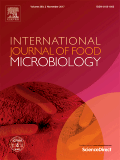Ver ítem
- xmlui.general.dspace_homeCentros Regionales y EEAsCentro Regional Mendoza - San JuanEEA MendozaArtículos científicosxmlui.ArtifactBrowser.ItemViewer.trail
- Inicio
- Centros Regionales y EEAs
- Centro Regional Mendoza - San Juan
- EEA Mendoza
- Artículos científicos
- Ver ítem
Culture-dependent and independent techniques applied to monitor yeast species on cold soak at different temperatures in winemaking
Resumen
Transformation of grape must into wine is a process that may vary according to the consumers' requirements. Application of cold soak prior to alcoholic fermentation is a common practice in cellars in order to enhance flavor complexity and extraction of phenolic compounds. However, the effect of this step on wine yeast microbiota is not well-known. The current study simultaneously analyzed the effect of different cold soak temperatures on the
[ver mas...]
Transformation of grape must into wine is a process that may vary according to the consumers' requirements. Application of cold soak prior to alcoholic fermentation is a common practice in cellars in order to enhance flavor complexity and extraction of phenolic compounds. However, the effect of this step on wine yeast microbiota is not well-known. The current study simultaneously analyzed the effect of different cold soak temperatures on the microbiological population throughout the process and the use of culture-dependent and independent techniques to study this yeast ecology. The temperatures assayed were those normally applied in wineries: 2.5, 8 and 12 °C. PCR-DGGE allowed detection of themost representative species such as Hanseniaspora uvarum, Starmerella bacillaris and Saccharomyces cerevisiae. As could be expected, highest diversity indices were obtained at the beginning of each process, and survival of H. uvarum or S. bacillaris depended on the temperature. Our results are in agreement with those obtained with culture independent methods, but qPCR showed higher precision and a different behavior was observed for each yeast species and at each temperature assayed. Comparison of both culture-independent techniques can provide a general overview of the whole process, although DGGE does not reveal the diversity expected due to the reported problems with the sensitivity of this technique
[Cerrar]

Fuente
International journal of food microbiology 237 : 142-149. (November 2016)
Fecha
2016
ISSN
0168-1605
Formato
pdf
Tipo de documento
artículo
Palabras Claves
Derechos de acceso
Restringido
 Excepto donde se diga explicitamente, este item se publica bajo la siguiente descripción: Creative Commons Attribution-NonCommercial-ShareAlike 2.5 Unported (CC BY-NC-SA 2.5)
Excepto donde se diga explicitamente, este item se publica bajo la siguiente descripción: Creative Commons Attribution-NonCommercial-ShareAlike 2.5 Unported (CC BY-NC-SA 2.5)

